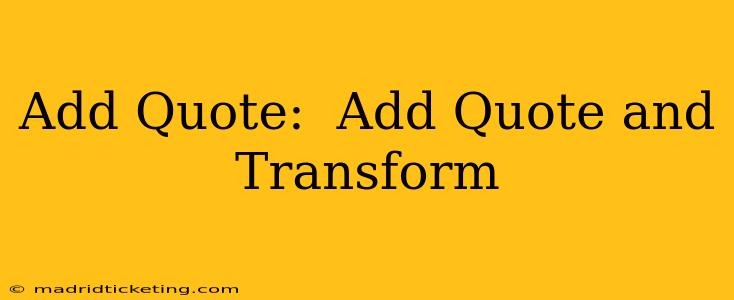Add Quote: Enhancing Your Content with Powerful Quotations
Adding quotes to your writing can significantly enhance its impact, adding credibility, depth, and memorability. Whether you're crafting a blog post, an essay, or a presentation, the right quote can elevate your content from ordinary to extraordinary. But simply adding any quote won't do. This guide will delve into the art of choosing, integrating, and transforming quotes to maximize their effect.
Why Add Quotes? The Power of Persuasion
Quotes offer several compelling benefits:
- Boost Credibility: Using quotes from respected experts or authorities instantly lends weight and authority to your arguments. Readers are more likely to trust information backed by credible sources.
- Illustrate Points: A well-chosen quote can succinctly illustrate a complex idea, making it more accessible and engaging for your audience.
- Add Emotional Depth: Quotes can evoke powerful emotions, connecting with readers on a deeper, more personal level. A moving quote can leave a lasting impression.
- Break Up Text: Quotes provide visual breaks in large blocks of text, improving readability and preventing monotony.
Choosing the Right Quote: A Critical Selection Process
Not all quotes are created equal. The selection process is crucial:
- Relevance is Key: The quote must directly relate to the point you're making. Avoid irrelevant quotes just for the sake of including them.
- Accuracy Matters: Ensure the quote is accurate and properly attributed. Misquoting a source can severely damage your credibility.
- Consider Your Audience: Choose quotes that resonate with your target audience. A quote that appeals to academics might not resonate with a general audience.
- Explore Diverse Sources: Don't limit yourself to a single source. Explore various books, articles, speeches, and interviews to find the perfect quote.
How to Integrate Quotes Effectively: Seamless Incorporation
Simply dropping a quote into your text isn't enough. Effective integration requires careful consideration:
- Introduce Your Quote: Always introduce your quote with a sentence or two of context. This sets the stage and explains why the quote is relevant. For example: "As renowned physicist Albert Einstein famously stated,..."
- Contextualize the Quote: After the quote, provide additional context or analysis to explain its significance to your point. This ensures your readers understand how the quote supports your argument.
- Use Proper Attribution: Always cite the source of the quote, including the author's name and the work from which it's taken. Use proper formatting (e.g., MLA, APA) depending on your context.
Transforming Quotes: Beyond Simple Insertion
Integrating quotes effectively isn't just about placement; it's about leveraging their full potential. Consider these techniques:
- Paraphrasing: If a quote is too long or complex, paraphrase it to convey the main idea more concisely. Remember to still cite the original source.
- Quoting a Portion: You don't always have to use the entire quote. Extract the most relevant portion to avoid disrupting the flow of your text.
- Connecting Quotes: Use multiple quotes to build a more comprehensive argument, creating a tapestry of ideas.
How Do I Add a Quote to My Work Correctly?
This involves careful consideration of several factors. You need to ensure the quote is relevant to your topic, accurately reproduced, properly attributed, and seamlessly integrated into the flow of your text. Always consider the context and audience, making sure the quote enhances the overall message and understanding.
What are the Rules for Using Quotes in Academic Writing?
Academic writing typically follows specific citation styles (e.g., MLA, APA, Chicago). These styles dictate how quotes are formatted, cited, and integrated into your work. Each style has its own set of rules regarding quotation marks, in-text citations, and bibliography entries. Consult the relevant style guide for detailed instructions.
How Can I Make My Quotes More Engaging?
Making your quotes more engaging involves thoughtful selection and strategic integration. Choose quotes that are memorable, insightful, or thought-provoking. Introduce them effectively, contextualize them thoroughly, and use techniques like paraphrasing or connecting multiple quotes to create a dynamic narrative.
By mastering the art of adding quotes, you can significantly elevate the quality and impact of your writing, transforming your work into something truly compelling and memorable.

